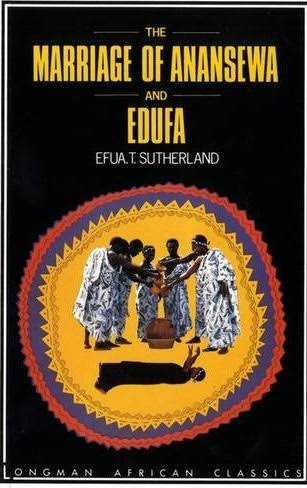
🎥 We’re cooking something delicious for you on our YouTube channel. In the coming days, you will learn SSCE literature texts like you're in class 📚✍🏽
Be part of this new journey we are about to embark on.
🔔 Subscribe Now
Act 3 of The Marriage of Anansewa
Setting and Opening Scene
Act 3 of The Marriage of Anansewa opens with Aya, Ananse’s mother, and Ekuwa, her sister (Ananse’s aunt), in conversation about Anansewa’s marriage preparations. Aya recalls the memory of Ananse’s late wife and expresses both affection and worry about her granddaughter’s future.
Aya also voices her suspicion of Miss Christie. She believes that Christie’s interest in helping with Anansewa’s marriage is motivated by her attraction to Ananse himself:
“She is leaning her ladder on my grandchild in order to climb up to my son.”
This early domestic scene establishes both family tension and comedic undertone. In it, there is a combination of gossip and genuine concern.
Main Events
The bridal purification ceremony soon begins. Girls sing praises and perform ritual acts to bless Anansewa. Aya leads the ceremony; she recounts how Anansewa was bathed early that morning with new sponge and soap and “life-giving water.”
Ekuwa adds nyanya leaves to the water, which is a traditional symbol of purification and protection, and places an egg before Anansewa to invite good fortune. The atmosphere is joyous and symbolic of the community’s rich cultural heritage.
Miss Christie and some of the other girls contribute coin gifts. The girls bless Anansewa with songs:
“Anansewa, you are now ready to marry;
Anansewa, you will give birth to thirty;
Anansewa, may your life be healthy.”
Aya then calls for silence and invites Ananse to pray for his daughter.
Conflict and Turning Point
In the midst of the celebration, a messenger from the Mines arrives with news that the Chief of the Mines also intends to bring a head-drink for Anansewa. Ananse is deeply disturbed; yet another suitor is now making an official move.
When Christie learns that other suitors exist besides Chief-Who-Is-Chief, she is shocked and disappointed in Ananse’s deception.
Moments later, Anansewa herself enters, joyful about her upcoming marriage, but her excitement fades when her father confesses that four chiefs, not one, plan to perform marriage rites for her. She tearfully insists that her heart belongs only to Chief-Who-Is-Chief.
In response, Ananse unveils a desperate plan:
To fake Anansewa’s death.
He convinces her that pretending to die will allow them to test the suitors’ loyalty and discover who truly cares for her.
Ananse’s Deception Deepens
Ananse calls Miss Christie back and shares the plan with her. Loyal to him, Christie agrees to assist and is tasked with finding a taxi to send Aya and Ekuwa back to their hometown, Nanka, so they will not witness the deception.
When Aya re-enters and finds her son worried, Ananse lies that their cocoa farm has been set on fire by enemies. Distraught, Aya quickly prepares to leave with Ekuwa, exactly as Ananse intended.
The Storyteller reappears. He laughs and comments on Ananse’s growing web of deceit. The act ends with the plan clearly set:
Ananse will announce Anansewa’s death and stage a mock funeral to see which suitor’s reaction reveals true affection. He hopes the most sincere one will be Chief-Who-Is-Chief.

Themes in Act 3 of The Marriage of Anansewa
- Deception and Manipulation: Ananse’s schemes reach their peak as he fakes his daughter’s death.
- Tradition and Modernity: The blending of Christian elements (church, formal education) with traditional rites (purification, head-drink) mirrors Ghana’s evolving society.
- Family and Gender Roles: Aya’s motherly protection contrasts with Ananse’s exploitative fatherhood.
- Love and Materialism: Anansewa’s preference for Chief-Who-Is-Chief introduces genuine emotion amid greed-driven transactions.
Dramatic Techniques in Act 3 of The Marriage of Anansewa
- Song and Ritual Performance: The purification ceremony combines music, chant, and symbolism to dramatise communal life.
- Comic Irony: The audience knows Ananse’s “game-plan”. This heightens both humour and suspense.
- Storyteller’s Commentary: Maintains the folk-drama style and guides audience interpretation.
- Symbolism: Nyanya leaves (purity), the egg (prosperity), and water (life) enrich the cultural context.
Study Tip
Act 3 represents the height of Ananse’s deception and the moral turning point of the play. Students should note how Sutherland uses folk ritual, song, and humour to expose social values: greed, love, and the boundaries of tradition in a changing world.
Questions on Act 3 of The Marriage of Anansewa
1. Act 3 focuses on ___
A. The discovery of Ananse’s deceit
B. The preparation for Anansewa’s “death”
C. The wedding ceremony
D. Ananse’s confession
2. What news does Ananse receive that prompts his plan?
A. All chiefs are coming for bride price
B. Chief-Who-Is-Chief has died
C. The chiefs are fighting
D. Christie refuses to help
3. Ananse’s “clever” solution is to ___
A. Send the money back
B. Pretend that Anansewa is dead
C. Marry her off secretly
D. Choose one chief
4. Miss Christie’s role in the fake death plan is to ___
A. Write the obituary
B. Supervise the act
C. Oppose it
D. Inform the chiefs
5. The players’ interjections during the act serve to ___
A. Ridicule Ananse
B. Explain his motive
C. Entertain the audience
D. Praise Anansewa
6. Ananse’s plan is motivated mainly by ___
A. Desire to test the chiefs’ love
B. Fear of poverty
C. Political ambition
D. Parental pride
7. The fake death symbolises ___
A. Punishment and resurrection
B. Transition and renewal
C. Wisdom and deceit
D. All of the above
8. What quality of Ananse is most highlighted in this act?
A. Hypocrisy
B. Intelligence
C. Laziness
D. Faith
9. How does the audience respond to the storyteller’s narration?
A. They are silent
B. They sing and clap
C. They question him
D. They leave the stage
10. What is the major dramatic device used in this act?
A. Foreshadowing
B. Irony
C. Soliloquy
D. Flashback
Also Read:
- Act 1 Summary of The Marriage of Anansewa by Efua Sutherland
- Act 2 Summary of The Marriage of Anansewa by Efua Sutherland
- Act 4 Summary of The Marriage of Anansewa by Efua Sutherland
Receive Literary Updates through our Social Media Channels:
- WhatsApp: Literature PADI
- Telegram: Literature PADI
- YouTube: @literaturepadi
- Facebook: Literature PADI





